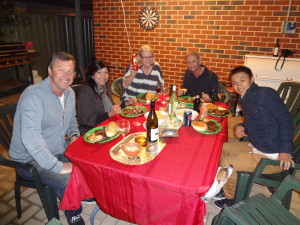We use particular language when we talk about photos.
(Less commonly paintings and pictures)
This language can be quite complex, but here we’ll stay more simple.
When we show somebody a photo, we usually describe the photo. To describe means you tell somebody about the photo, giving more details.
To describe a painting, picture or photo as you look at it, you usually use
verbs such as
is, are, doing, holding, eating, smiling, walking, looking, sitting, dancing, working
nouns such as
room, table, house, field, color, light, day, night, mountain, lake, hotel, bar, disco,
weather, fun, love, excitement, situation, nature
prepositions such as
into, next to, on, at, behind, near to, above, below, opposite
adjectives such as
happy, funny, bright, red, soft, friendly, beautiful, sad, scared, shocked, breathtaking, fantastic, magnificent, grand, picturesque, spectacular, tasty, delicious, exciting
adverbs such as
quietly, slowly, carefully, brightly, suddenly, strikingly
We often think of questions when we look at photos.
What is in it?
What can you see?
What else can you see?
describing:
There is ……
There are ……
I can see …..
It seems like …..
It looks as if ….
She looks ……
Who is in it?
Who is that? man, woman, boy, girl, person,
Is this a family/ work group/ sports group/ church group
Are they friends?
Do you know/ recognise him/them?
Do you think they are married?
The man is ……
The people are …..
The building looks ….
This is a …… family, married couple
There is a …..
What is happening? Has happened?
It’s a sports event.
There’s been an accident.
Some people are ….
They seem to be …..
It seems that ….
Where is this taking place?
Is it in Australia/ The US/ Japan/ France/ India/ Northern Hemisphere?
Examples, kitchen, school, church, restaurant
When is it happening?
Is it winter or summer?
A recent event or historical?
a famous occasion?
Please remember, you can use most of the language we have been talking about to also describe a painting or a picture.
Exercise Activity
Now, let’s look at a few photos for practice!
1.

2.
3.
4.
5.




